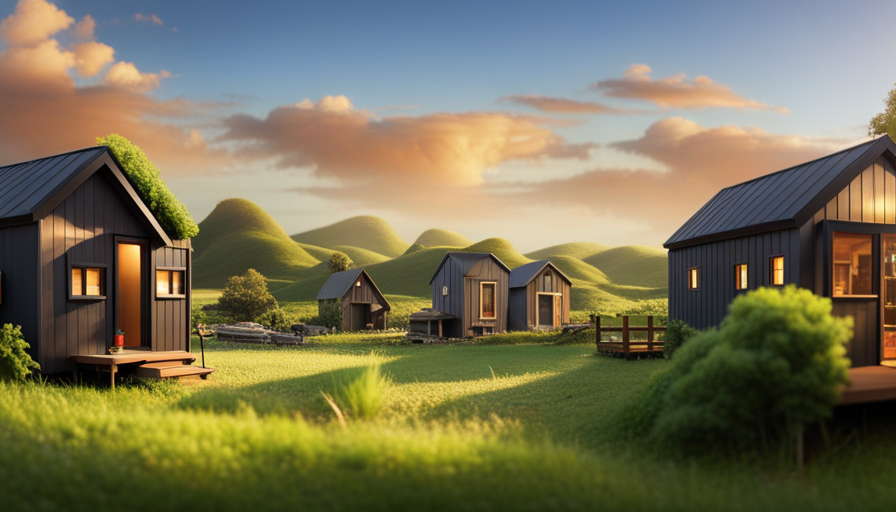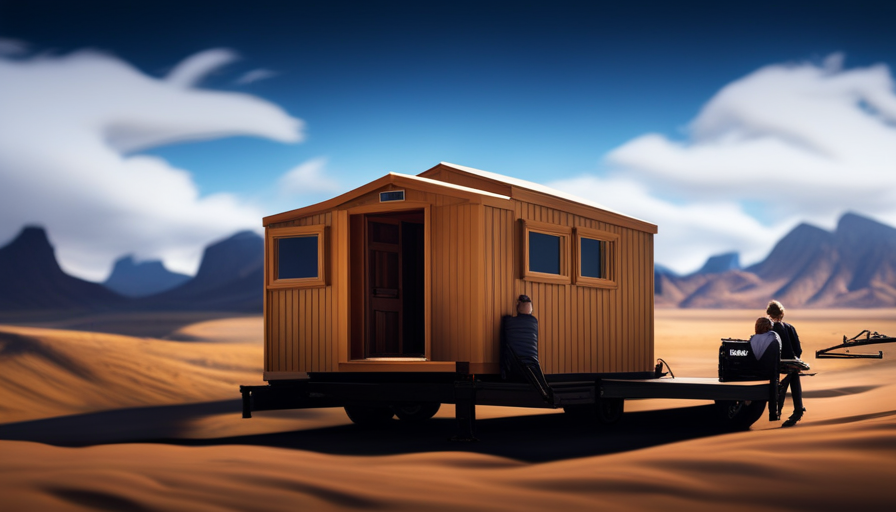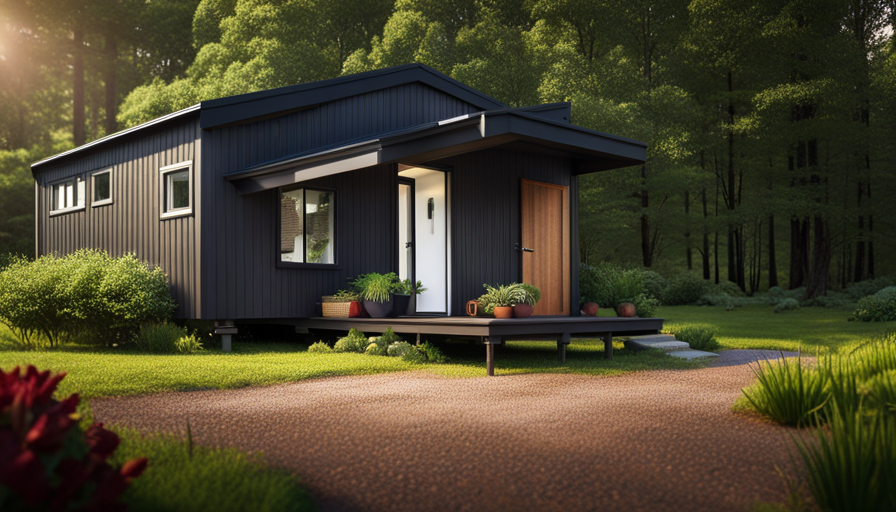Imagine being in a cozy home surrounded by trees, with sunlight gently shining through the windows, illuminating your face with a comforting glow. Everything around you is carefully curated, with each item serving a purpose and bringing joy to your everyday life.
This is the reality of living in a tiny house – a lifestyle that has captured the hearts and minds of many seeking a simpler, more intentional way of life.
In this article, we will explore the various ways in which living in a tiny house can make your life better. From the financial freedom and affordability it offers, to the simplified living and reduced environmental footprint, to the mobility, flexibility, and connection with nature that it promotes, we will delve into the many benefits of embracing this minimalist lifestyle.
So, join me as we embark on a journey to discover how living in a tiny house can truly enrich our lives.
Key Takeaways
- Financial benefits: Offers financial freedom and affordability, more affordable compared to traditional homes, encourages cost-saving measures like reducing energy consumption and utilizing alternative energy sources.
- Simplified living: Promotes simplified living and decluttering, saves time on cleaning and maintenance, efficient use of space allows for creative storage solutions and innovative design, embracing minimalism keeps surfaces clutter-free and makes cleaning easier.
- Environmental benefits: Reduces carbon footprint and promotes environmental sustainability, designed to maximize energy efficiency and incorporate sustainable features, encourages minimalism and conscious consumption, builders prioritize the use of sustainable materials.
- Mobility and flexibility: Offers mobility and flexibility, can be easily hitched to a vehicle for travel and exploration, allows for experiencing different landscapes, climates, and communities, easy relocation and adaptability allows for hassle-free moves and exploration opportunities.
Financial Freedom and Affordability
Living in a tiny house gives you the incredible opportunity to break free from the burdens of financial stress and finally embrace the freedom to live life on your own terms.
One of the most significant advantages of living in a tiny house is the financial independence it offers. With a smaller living space, you’ll undoubtedly save money on both the initial cost of purchasing the house and the ongoing expenses of maintenance and utilities. Tiny houses are generally more affordable compared to traditional homes, allowing you to invest your hard-earned money in other important aspects of your life, such as education, travel, or starting a business.
Additionally, living in a tiny house encourages cost-saving measures such as reducing energy consumption, minimizing waste, and utilizing alternative energy sources like solar power. These measures not only help you save money but also contribute to a more sustainable and environmentally-friendly lifestyle.
Transitioning into the subsequent section about simplified living, living in a tiny house not only provides financial benefits but also promotes a simpler and more intentional way of life.
Simplified Living
Living in a tiny house offers the opportunity to simplify our lives in numerous ways. One key aspect is decluttering and embracing minimalism, as the limited space forces us to prioritize our belongings and eliminate unnecessary clutter.
Additionally, the streamlined cleaning and maintenance of a tiny house means less time spent on chores and more time for other activities.
Lastly, the efficient use of space in a tiny house allows for creative solutions and innovative storage options, maximizing every square inch and ensuring that every item has its designated place.
Decluttering and Minimalism
Embrace the freedom of decluttering and minimalism, and discover how a tiny house can help you find peace amidst the chaos. Living in a tiny house forces you to prioritize your belongings and eliminate unnecessary clutter. With limited space, you quickly realize the importance of only keeping the things that truly add value to your life.
This process of decluttering benefits not only your physical space but also your mental well-being. By eliminating excess stuff, you create a calm and organized environment that promotes relaxation and reduces stress. The minimalist lifestyle that comes with living in a tiny house encourages you to focus on experiences and relationships rather than material possessions.
So, as you simplify your life and let go of the unnecessary, you’ll find that living in a tiny house brings a newfound sense of freedom and contentment. Transitioning to the next topic, streamlined cleaning and maintenance becomes effortless in a tiny house.
Streamlined Cleaning and Maintenance
With a tiny house, the act of cleaning becomes a therapeutic dance, as each swipe of the broom symbolizes the release of unnecessary burdens and the creation of a pristine sanctuary. Living in a small space requires time-saving techniques and organizational hacks to keep things tidy and efficient.
Here are four ways that streamlined cleaning and maintenance can make your life better in a tiny house:
-
Multifunctional furniture: Opt for furniture pieces that serve multiple purposes, such as a sofa that doubles as a storage unit or a bed that can be transformed into a desk. This reduces the amount of cleaning needed and maximizes the use of space.
-
Minimal surfaces: Embrace minimalism by keeping surfaces clutter-free. With fewer objects to dust or wipe down, cleaning becomes a breeze and you can spend more time enjoying your cozy space.
-
Compact cleaning tools: Invest in compact cleaning tools that are designed specifically for small spaces. Mini vacuums, handheld brooms, and collapsible mops are great for reaching tight corners and efficiently cleaning every nook and cranny.
-
Regular decluttering: Adopt a regular decluttering routine to avoid accumulating unnecessary items. By keeping your belongings to a minimum, you’ll spend less time organizing and cleaning, and more time doing the things you love.
Living in a tiny house allows for time-saving techniques and organizational hacks that make cleaning and maintenance a breeze. Efficient use of space is the next step towards maximizing the benefits of tiny house living.
Efficient Use of Space
Maximizing the use of space in a tiny house is essential for creating a functional and comfortable living environment. With limited square footage, it’s important to explore smart storage solutions and creative design ideas. One way to optimize space is by incorporating multi-functional furniture, such as a sofa that transforms into a bed or a dining table that doubles as a workspace. Additionally, utilizing vertical space through shelving or loft areas can provide ample storage for belongings.
To highlight the impact of efficient space utilization, consider the following table:
| Before Living in a Tiny House | After Living in a Tiny House | The Result |
|---|---|---|
| Cluttered and cramped rooms | Open and airy living spaces | Increased comfort |
| Overflowing closets | Organized and tidy storage | Reduced stress |
| Limited floor space | Multi-functional areas | Enhanced functionality |
By maximizing every inch of a tiny house, individuals can experience a more streamlined and organized lifestyle. Furthermore, efficient use of space in a tiny house contributes to environmental sustainability by minimizing the resources needed for construction and reducing energy consumption.
Environmental Sustainability
Living in a tiny house can significantly reduce your carbon footprint, as it requires less energy to heat, cool, and maintain compared to larger homes. This sustainable living choice not only benefits the environment but also brings financial savings and a simpler lifestyle. Here are three reasons why living in a tiny house promotes environmental sustainability:
-
Energy Efficiency: Tiny houses are designed to maximize energy efficiency. With a smaller space to heat and cool, energy consumption is reduced. Additionally, many tiny houses incorporate sustainable features such as solar panels, energy-efficient appliances, and insulation, further minimizing energy usage.
-
Reduced Waste: Living in a tiny house encourages minimalism and conscious consumption. The limited space forces residents to declutter and prioritize essential belongings, leading to reduced waste generation. Tiny house dwellers often adopt eco-friendly practices like composting, recycling, and using reusable products, further minimizing their environmental impact.
-
Sustainable Materials: Tiny house builders often prioritize the use of sustainable materials such as reclaimed wood, bamboo, and recycled materials. These materials are not only environmentally friendly but also contribute to the unique aesthetic and charm of the tiny house lifestyle.
Living in a tiny house embodies the principles of sustainability, allowing individuals to lead a more eco-conscious and mindful life. As we transition to the next section about mobility and flexibility, it’s important to consider how tiny houses offer not only a smaller environmental footprint but also increased freedom and adaptability in our living arrangements.
Mobility and Flexibility
Living in a tiny house offers me the ability to travel and explore more freely. With my compact and mobile living space, I can easily hitch it to a vehicle and hit the road whenever I desire.
This flexibility in choosing my location allows me to experience different landscapes, climates, and communities, enriching my life with new adventures. Additionally, the easy relocation and adaptability of a tiny house means that I can easily move to a new place whenever I feel the need for a change, without the hassle and expenses associated with traditional housing.
Ability to Travel and Explore
Traveling and exploring becomes a breeze when you can easily hitch your tiny house to your car and hit the open road. Living in a tiny house offers endless travel opportunities and a sense of adventure.
Whether it’s a weekend getaway or a cross-country road trip, you have the freedom to go wherever your heart desires. With your compact home on wheels, you can easily navigate through narrow roads and find unique, off-the-beaten-path destinations.
Imagine waking up to breathtaking views every day, whether it’s by the beach, in the mountains, or in a bustling city. The ability to travel with your tiny house allows you to experience different cultures, meet new people, and create unforgettable memories.
Plus, the flexibility in choosing your next location is just one of the many benefits of living in a tiny house, providing you with endless possibilities for adventure and exploration.
Flexibility in Choosing Location
Living in a tiny house not only allows for the freedom to travel and explore, but it also offers flexibility in choosing the perfect location to settle down. With a tiny house, I have the ability to pick and choose where I want to live, whether it’s in the mountains, by the beach, or near a bustling city.
This flexibility is especially advantageous for those who have remote work opportunities. They can work from anywhere, and a tiny house provides the perfect solution. In addition, the lower cost of living in a tiny house allows for more financial freedom to pursue new experiences and adventures.
This newfound freedom to explore and the availability of remote work opportunities make living in a tiny house an ideal lifestyle choice. It’s no wonder that tiny houses are becoming increasingly popular. With easy relocation and adaptability, you can truly make a tiny house your home, anywhere you desire.
Easy Relocation and Adaptability
With its easy relocation and adaptability, a tiny house allows you to effortlessly transform your living space to suit your changing needs and desires. The relocation benefits of living in a tiny house are numerous. You can easily move your home to a new location whenever you want, whether it’s to be closer to family or to explore a new city. The adaptability advantages are equally important. A tiny house can be customized and modified to fit your lifestyle, whether you need a home office, a workout space, or a guest room. The table below illustrates some of the ways in which a tiny house can be adapted to meet your specific needs:
| Need | Tiny House Solution |
|---|---|
| Home Office | Convert a nook into a functional workspace. |
| Workout Space | Utilize the outdoors or create a small gym area. |
| Guest Room | Install a fold-out bed or a loft space. |
| Storage | Maximize vertical space with built-in shelving. |
| Outdoor Living | Create an inviting patio or deck area. |
Living in a tiny house not only offers flexibility in location and adaptability in design, but it also allows for a stronger connection with nature, as you’ll see in the next section.
Connection with Nature
Surrounded by panoramic views and nestled among trees, living in a tiny house allows for an intimate connection with nature that soothes the soul. One of the key features that enables this connection is the concept of biophilic design. Biophilic design incorporates natural elements into the structure and layout of the tiny house, creating a seamless transition between indoor and outdoor living. Large windows bring the outside in, flooding the space with natural light and offering breathtaking views of the surrounding landscape. This design approach not only enhances the aesthetic appeal of the tiny house but also promotes a sense of calm and well-being.
Outdoor living is also an integral part of the tiny house experience. With limited indoor space, tiny house dwellers are encouraged to spend more time outside, making the most of their natural surroundings. Whether it’s enjoying a cup of coffee on the porch, tending to a small garden, or simply taking a leisurely stroll in the nearby woods, the opportunities for outdoor activities are endless. This connection with nature not only provides a sense of tranquility but also encourages a more mindful and intentional way of living.
By fostering a deep connection with the natural world, living in a tiny house sets the stage for a shift towards mindful and intentional living. The simplicity and minimalism of the tiny house lifestyle allow individuals to focus on what truly matters, prioritizing experiences over possessions. This transition into a more intentional way of living will be explored in the subsequent section, highlighting the transformative power of tiny house living.
Mindful and Intentional Living
Immerse yourself in the transformative power of mindful and intentional living, as the simplicity and minimalism of a tiny house lifestyle encourage you to prioritize experiences over possessions.
Living in a tiny house allows you to cultivate increased mindfulness, as the limited space forces you to be more aware of your surroundings and the items you bring into your home. With fewer distractions and less clutter, you can focus on the present moment and fully appreciate the beauty of your surroundings.
Intentional decision making becomes second nature when living in a tiny house. Every item you bring into your home must serve a purpose and have a designated place, promoting a more deliberate approach to consumption. You become more conscious of your choices and develop a greater appreciation for the things that truly add value to your life.
Here are four ways in which living in a tiny house encourages mindful and intentional living:
-
Simplified Living: With limited space, you are forced to declutter and let go of unnecessary belongings, leading to a simpler and more organized environment.
-
Environmental Awareness: The smaller footprint of a tiny house promotes sustainability and encourages eco-friendly practices, such as using renewable energy sources and conserving resources.
-
Financial Freedom: Living in a tiny house often means reduced expenses, allowing you to live more within your means and focus on experiences rather than material possessions.
-
Emotional Well-being: The minimalist lifestyle of a tiny house promotes a sense of calm and tranquility, reducing stress and increasing overall well-being.
Living in a tiny house offers a unique opportunity to align your values with your living space, fostering a deeper connection with yourself, your surroundings, and the world around you. It’s a lifestyle that encourages increased mindfulness and intentional decision making, ultimately leading to a more fulfilling and meaningful life.
Frequently Asked Questions
What are some tips for finding affordable land to park a tiny house on?
Finding affordable land to park a tiny house can be a challenge, but there are some tips that can help.
First, consider rural areas where land prices are usually lower.
Look for properties that aren’t zoned for residential use, as they may be more affordable.
Additionally, consider reaching out to local landowners or farmers who may be open to renting out a portion of their land.
Lastly, join online communities and forums dedicated to tiny house living, as they can provide valuable insights and connections for finding suitable parking options.
How do tiny house owners typically handle the cost of utilities and other monthly expenses?
Handling expenses and managing utilities in a tiny house can be a challenge, but it’s worth it. I’ve learned to be resourceful and creative, finding ways to lower my monthly bills.
From using solar panels for electricity to collecting rainwater for my water supply, I’ve become more conscious of my carbon footprint.
Additionally, I’ve found that living in a tiny house has allowed me to prioritize experiences over possessions, leading to a simpler and more fulfilling lifestyle.
Are there any restrictions or regulations regarding where you can park a tiny house?
There are parking restrictions and zoning regulations that can impact where you can park a tiny house. These restrictions vary depending on the location and local regulations.
Some areas may have specific zoning laws that prohibit parking a tiny house on certain properties or in certain neighborhoods. Additionally, there may be restrictions on the length of time a tiny house can be parked in a particular location.
It’s important to research and understand the specific regulations in your area before choosing a spot to park your tiny house.
Can you finance a tiny house purchase, and if so, what are the options available?
Yes, you can finance a tiny house purchase. There are several financing options available, such as personal loans, RV loans, and construction loans. When choosing the right loan, consider factors like interest rates, repayment terms, and eligibility requirements.
Owning a tiny house on wheels has its benefits, including mobility and flexibility. To find affordable financing, compare rates and terms from different lenders. However, it’s important to note that financing a tiny house can come with challenges due to the unique nature of these homes.
Resources like tiny house financing companies and online platforms can help you navigate the process.
What are some potential drawbacks or challenges of living in a tiny house that people may not consider?
Living in a tiny house has its challenges. One of the potential drawbacks is the limited space. It can be difficult to find storage for all your belongings and to have enough room for activities.
Additionally, living in such a small space may require you to downsize and let go of sentimental items. It can also be challenging to have guests over, as the lack of space may make entertaining difficult.
However, despite these challenges, many people find the simplicity and minimalism of tiny house living to be rewarding.
Conclusion
Living in a tiny house has truly transformed my life for the better. Not only has it provided me with financial freedom and affordability, but it has also simplified my daily living and allowed me to be more mindful and intentional with my choices.
The environmental sustainability aspect has also been a game-changer, as I’m now living a more eco-friendly lifestyle.
The mobility and flexibility of a tiny house have given me the opportunity to explore new places and connect with nature in ways I never thought possible.
Overall, I can’t help but ask myself, "Why didn’t I do this sooner?"
Hi, I’m Emma. I’m the Editor in Chief of Tiny House 43, a blog all about tiny houses. While tree houses are often associated with childhood, they can be the perfect adult retreat. They offer a cozy space to relax and unwind, surrounded by nature. And since they’re typically built on stilts or raised platforms, they offer stunning views that traditional homes simply can’t match. If you’re looking for a unique and romantic getaway, a tree house tiny house might just be the perfect option.










